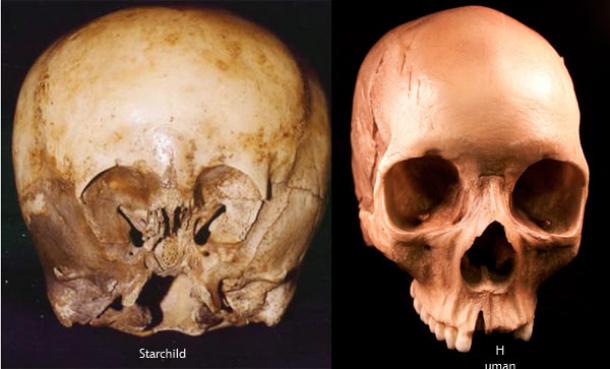It was back in the 1930s when an American teenager discovered an abandoned mine tunnel in Mexico’s Copper Canyon region. Inside it she found a human skeleton and, clutching onto its arm, was the hand bone of another skeleton buried mostly under the earth. It was described as being small and misshapen. The teenager returned to the site the following day only to find that a flash flood had washed most of the bones away. Nevertheless, the upper section of the skull of the buried skeleton, along with a small piece of the upper jaw bone remained. The significance of the skull remained unrealised for nearly 70 years. In 1999, the highly unusual skull, which has been dated at 900 years old, was handed to author and researcher Lloyd Pye to investigate after health professionals failed to identify a condition that could explain its appearance. The skull became known as the “Starchild Skull,” and between 1999 and 2013, Lloyd enlisted the help of numerous experts and independent medical and scientific institutions across three countries (USA, Canada, and the United Kingdom) to conduct extensive research and testing. One of the major contributors to the research project was Dr Ted Robinson, who had a background in medicine and plastic surgery and specialised knowledge of cranial surgery and cranial anatomy. Dr Robinson studied the skull for a period of two years and involved specialists in the disciplines of radiology, ophthalmic surgery, oral surgery, craniofacial surgery, neurology and paediatric neurosurgery. The report Dr Robinson prepared was astounding. Firstly, Dr Robinson’s expertise in cranial deformities enabled him to rule out all the human deformities he knew of that could account for the skull’s appearance, nor were any of the other specialists able to find any deformity, illness or cultural practice that could account for the misshapen head. Secondly, Dr Robinson reported that the bone of the skull is much thinner, lighter, and stronger than regular human bone, it contains unusual reinforcing fibres, the brain is 30% larger than a normal human of its size, the frontal sinuses are absent, the eye sockets are shallow, and the entire skull has over 10 standard deviations from the human norm, a highly unusual statistic. Robinson wrote: “One can only reasonably conclude from these statistical studies that the Starchild skull is distinctly different from human.” Nevertheless, the medical reports and investigations were not enough to convince mainstream scientists that this skull was definitely not human. Instead, they explained away the abnormalities with the claim that ‘nature can do anything’. The scientists running the Starchild Project knew that the only definitive way of proving that the skull was not human was through DNA testing. So they waited nearly a decade while the technology for recovering and sequencing “ancient” DNA, such as the 900-year-old Starchild’s, could be perfected. In 2010, the Project secured access to a highly sophisticated ancient DNA lab capable of recovering non-human DNA. Preliminary DNA testing found that a significant percentage of the DNA in the skull appears to not be human, a finding that, if verified, would indicate the skull belongs to a new species. In 2012, a geneticist was able to secure a fragment of gene from the 5% of human nuclear DNA that code for proteins and which is a highly functional ‘master gene’, one of the most vitally important genes in the body of any species on Earth. It is known as the FOXP2 gene. An analysis was carried out on this gene, the full report of which can be read here, and the results were again startling. The FOXP2 gene in normal humans is 2,594 base pairs long and contains no variations. In mammals and other “higher” species, any single flaw in FOXP2, any isolated mutation or variation, can cause a severe negative impact in some of the most important aspects of development and will normally lead to death. While a tiny amount of survivable mutations are possible in FOXP2, every one that occurs presents debilitating or life-threatening consequences, so up to this point in time none have been passed on to the general population of humans. This means in the vast, vast majority of humans, the FOXP2 master gene is absolutely identical. The fragment of gene that was recovered from the skull and analysed is 211 base pairs long (out of 2,594 base pairs). Now comes the incredible result of the analysis. While all normal humans have the exact same base pairs, the Starchild’s gene contained a total of 56 variations within the fragment! To understand the significance, in a rhesus monkey only 2 of its 211 base pairs would contain variation from humans. If it were a mouse, it would be 20. If a dog, 27. To put this in perspective, let’s imagine that when alive, the Starchild was indeed some unknown humanoid. No matter how different from humans it might have been, to be in the humanoid family its FOXP2 gene would have to be in the range of 1 or 2 or at most 3 base pair variations from a normal human. To go past 5 or 10 would put it into another class of species. To have 56 is to put it in another realm, another dimension entirely. It is utterly unique. These amazing findings are the result of only a partial analysis of the DNA. This year the Starchild Project was registered as a company in order to raise the necessary funds to undertake a complete DNA test, which will determine once and for all the true nature of this most unusual species. – See more at: http://www.ancient-origins.net/unexplained-phenomena/humanoid-skull-unlike-any-other-001069#sthash.cKIZOaHB.dpuf
-
Primary Widget Area
-
This theme has been designed to be used with sidebars. This message will no
longer be displayed after you add at least one widget to the Primary Widget Area
using the Appearance->Widgets control panel.
- Log in

